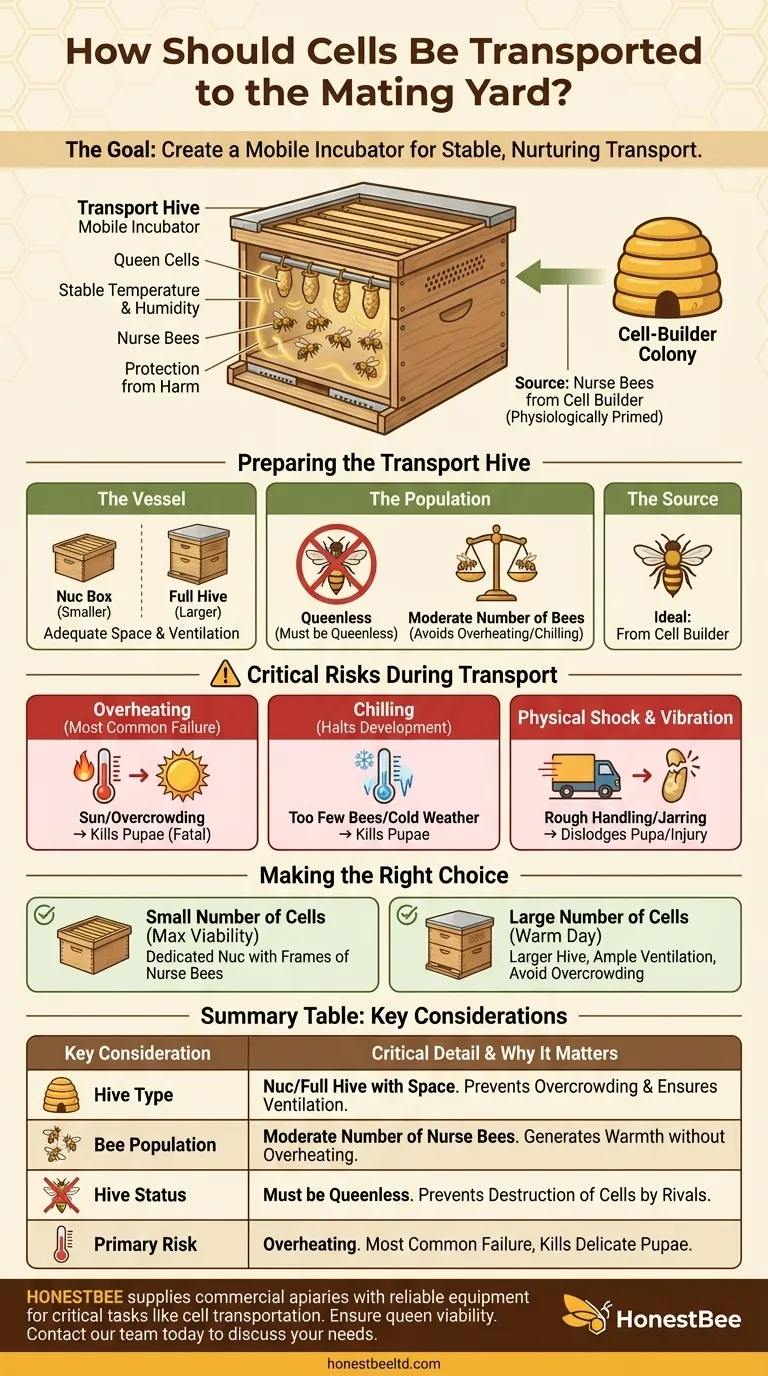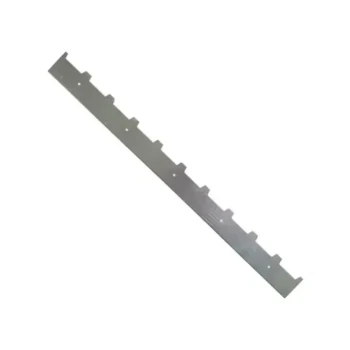To transport queen cells, they must be placed in a specially prepared, queenless "cell-carrying hive." This can be a full-sized hive or a smaller nucleus box, but it should be populated with a moderate number of nurse bees taken from a cell-builder colony. The key is to create a mobile incubator that maintains the correct temperature and humidity without overcrowding the bees, which could cause the delicate cells to overheat and fail.
Your goal during transport is not just to move the cells, but to perfectly replicate the stable, nurturing environment of the original cell-builder hive. Success depends entirely on maintaining temperature, humidity, and protection from harm.

Preparing the Transport Hive: Your Mobile Incubator
Think of the transport box not as mere conveyance, but as a life-support system for the developing queens. Every decision should be made to ensure a stable and safe environment.
The Vessel: Nuc Box or Full Hive
The container itself can be a standard hive body or a smaller nucleus box (nuc). The choice depends on the number of cell bars you are moving.
The key is that the box provides enough space for the cell bars, the bees, and adequate ventilation.
The Population: Queenless and Calm
The transport hive must be queenless. The presence of a queen would trigger the bees to identify the queen cells as rivals, and they would be promptly destroyed.
The hive should be populated with only a moderate number of bees. Too few bees will fail to generate the warmth and humidity needed to keep the cells viable. Too many bees will create an excess of metabolic heat, leading to a fatal overheating of the cells.
The Source: Using Bees from a Cell Builder
The ideal bees for this task are those taken directly from the cell-builder hive. These bees are already in a "nurturing" state, physiologically primed to care for developing queens.
Shaking bees from a random honey-production colony is less ideal, as they may not provide the same level of immediate care.
Critical Risks During Transport
Transport is the most vulnerable stage for queen cells. Understanding the risks is the first step to mitigating them. The primary threats are thermal stress and physical damage.
The Danger of Overheating
This is the single most common cause of failure during transport. An overcrowded transport box, especially on a warm day or left in direct sunlight, can quickly become an oven.
The delicate pupae inside the cells are extremely sensitive to high temperatures, and even a brief period of overheating can kill them or cause developmental defects.
The Threat of Chilling
Conversely, if too few bees are used or if transport occurs in cold weather without protection, the cells can become chilled. This will also halt development and kill the pupae.
The cluster of nurse bees acts as a living furnace and humidifier, and it must be large enough to perform this function effectively.
Physical Shock and Vibration
Developing queens are fragile. Rough handling, excessive vibration from the vehicle, or jarring movements can dislodge the pupa from its food source (the royal jelly) or cause direct physical injury.
Secure the cell bars firmly within the transport hive and drive carefully to minimize these forces.
Making the Right Choice for Success
Your setup should be tailored to the specific conditions of the day and the number of cells you are moving.
- If your primary focus is maximum viability for a small number of cells: Use a dedicated nucleus box with several frames of nurse bees from the original cell builder to create a perfectly controlled micro-environment.
- If you are transporting a large number of cells on a warm day: Prioritize preventing overheating by using a larger hive body with ample ventilation and being especially careful not to overcrowd the bees.
Ultimately, successful transport is achieved by meticulously managing the environment to protect the developing queens within their cells.
Summary Table:
| Key Consideration | Critical Detail | Why It Matters |
|---|---|---|
| Hive Type | Nuc box or full hive with adequate space. | Prevents overcrowding and ensures proper ventilation. |
| Bee Population | Moderate number of nurse bees from a cell-builder colony. | Generates necessary warmth without causing fatal overheating. |
| Hive Status | Must be queenless. | Prevents bees from destroying the queen cells as rivals. |
| Primary Risk | Overheating from too many bees or sun exposure. | The most common cause of failure; kills delicate pupae. |
Transporting queen cells is a high-stakes operation. Your success depends on reliable equipment and proven techniques.
HONESTBEE supplies commercial apiaries and beekeeping equipment distributors with the durable, well-designed supplies needed for critical tasks like cell transportation. From sturdy nucleus boxes to essential protective gear, our wholesale-focused operations ensure you have access to the tools for success.
Ensure the viability of your valuable queens. Contact our team today to discuss your equipment needs and how we can support your commercial beekeeping operations.
Visual Guide

Related Products
- HONESTBEE Professional Hive Top Bee Feeder Feeding Solution
- Professional Hive Top Bee Feeder for Beekeeping
- Professional Hive Front Entrance Bee Feeder
- 3.5L Plastic Beehive Frame Feeder Deep Frame Water Feeder for In Hive Use
- Boardman Entrance Bee Feeder Durable Galvanized Steel and Wood Construction for Beekeeping
People Also Ask
- What should be done with feeders and equipment after feeding bees? Essential Steps for Apiary Health
- What safety features are included in top feeders? A Guide to Drowning Prevention and Hive Safety
- Why is a top feeder essential for bees? Ensure Colony Health and Efficiency
- What are the advantages of hive top feeders? Maximize Feeding Efficiency for Your Apiary
- How do I keep bees from drowning in my top feeder? Ensure Safe Feeding for Your Hive



















